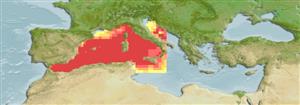Teleostei (teleosts) >
Myctophiformes (Lanternfishes) >
Myctophidae (Lanternfishes) > Gymnoscopelinae
Etymology: Notoscopelus: Greek, noton = back + Greek, skopelos = a lantern fish (Ref. 45335).
Environment: milieu / climate zone / depth range / distribution range
Ecology
Marine; pelagic-oceanic; oceanodromous (Ref. 51243); depth range 45 - 1000 m. Subtropical; 45°N - 35°N, 6°W - 17°E
Mediterranean Sea: endemic to the western region.
Size / Weight / Age
Maturity: Lm ? range ? - ? cm
Max length : 14.2 cm SL male/unsexed; (Ref. 30504)
High-oceanic, found between 375-1,000 m during the day and between 45-150 m at night. Spawns from winter to spring.
Life cycle and mating behavior
Maturity | Reproduction | Spawning | Eggs | Fecundity | Larvae
Bauchot, M.-L., 1987. Poissons osseux. p. 891-1421. In W. Fischer, M.L. Bauchot and M. Schneider (eds.) Fiches FAO d'identification pour les besoins de la pêche. (rev. 1). Méditerranée et mer Noire. Zone de pêche 37. Vol. II. Commission des Communautés Européennes and FAO, Rome. (Ref. 3397)
IUCN Red List Status (Ref. 130435: Version 2024-2)
Threat to humans
Harmless
Human uses
Tools
Special reports
Download XML
Internet sources
Estimates based on models
Preferred temperature (Ref.
123201): 13.1 - 14.3, mean 13.6 °C (based on 61 cells).
Phylogenetic diversity index (Ref.
82804): PD
50 = 0.5156 [Uniqueness, from 0.5 = low to 2.0 = high].
Bayesian length-weight: a=0.00447 (0.00245 - 0.00814), b=3.17 (3.00 - 3.34), in cm total length, based on LWR estimates for this species & (Sub)family-body (Ref.
93245).
Trophic level (Ref.
69278): 3.4 ±0.45 se; based on food items.
Generation time: 1.2 ( na - na) years. Estimated as median ln(3)/K based on 1
growth studies.
Resilience (Ref.
120179): High, minimum population doubling time less than 15 months (K=0.89).
Fishing Vulnerability (Ref.
59153): Low vulnerability (10 of 100).
Nutrients (Ref.
124155): Calcium = 225 [81, 565] mg/100g; Iron = 2.09 [0.94, 5.05] mg/100g; Protein = 17.4 [15.3, 19.5] %; Omega3 = 0.728 [0.324, 1.795] g/100g; Selenium = 35.6 [14.9, 98.5] μg/100g; VitaminA = 26.8 [6.7, 144.0] μg/100g; Zinc = 1.06 [0.64, 1.72] mg/100g (wet weight);
